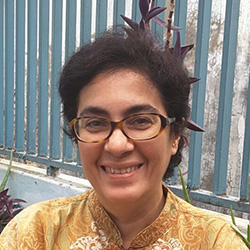In the last two decades, annual tropical forest cover loss around the world has increased despite numerous efforts to counter the trend. REDD+, short for Reducing Emissions from Deforestation and forest Degradation, is a framework to guide activities in the forest sector to effectively reduce emissions. It was adopted at the UNFCCC COP13 in Bali, Indonesia in 2007.
The basic idea of REDD+ was payment for ecosystem services. It is a simple textbook idea, where countries receive payments for the reduced carbon emissions from preventing or reducing deforestation and degradation, and for enhancing forest carbon stocks. However, achieving the outcomes proved to be not as simple as it sounds on paper.
Arild Angelsen, a professor at the Norwegian University of Life Sciences (NMBU) and Center for International Forestry Research and World Agroforestry (CIFOR-ICRAF) Senior Associate, delivered a lecture on REDD+ and a discussion on deforestation diagnostics at the University of Indonesia on 15 and 16 December 2022. Angelsen’s presentation is part of efforts to disseminate knowledge and exchange lessons learned in Phase 4 of the Global Comparative Study on Reducing Emissions from Deforestation and Forest Degradation (GCS REDD+).
Deforestation diagnostics
Deforestation diagnostics is an approach that is inspired by clinical medicine. It checks symptoms to define the illness to determine what treatment to give. In a diagnostics process, we ask questions about critical variables to understand the case at hand. Similarly, in statistics, we update probabilities based on new evidence. “For example, if the weather forecast says there is a high probability of rain tomorrow, then we plan to bring an umbrella,” said Angelsen. “But if we observe no clouds the next day, we lower that probability.”
Diagnostics are also applied in other scientific fields such as economics and political science, for example to identify impediments to economic growth. Deforestation diagnostics is a new application that will allow us to figure out which policies are likely to provide the best conservation outcomes in a given location or archetype. “It is finding the sweet middle spot between generalizations and one-size-fits-all solution on the one hand, and a belief that every case is unique on the other,” said Angelsen.
Why deforestation diagnostics?
Deforestation diagnostics is useful for policy makers and practitioners as a tool for identifying the most robust policy interventions. It helps us to understand the challenges at hand across similar locations – and across national borders. For case researchers, it is useful to identify critical factors for understanding individual cases and locate them within the broader universe of tropical forest contexts. In general, the approach will help in the aggregation of studies by providing more structured case-data, and thus improve future assessments of “what would work where, and why?”
The first step in this approach is to build a set of archetypes. An archetype analysis is done to allow identifying commonalities and differences for important deforestation and forest degradation contexts. Angelsen said that the archetype analysis can be done with new data and tools, such as artificial intelligence. However, this does not mean that this process can be left automated. “We still need human intelligence,” he said, “and we need to categorize different contexts, in a way that is both informed by theory and in line with evidence, to arrive at a sensible context.”
In defining archetypes, a nested approach is applied. This means that at first, variables are chosen in broad categories; then, they are further split into sub-categories, and so on. The archetype classification defines the relevant locations to learn from, and will not replace local, context-specific insights – rather, it builds on this knowledge and aims to systematize and aggregate it.
Early findings
In the first year of the project, a set of tropical deforestation and forest degradation archetypes was identified. In the model that was built, metrics for landcover change and typologies of forests are considered to feed into the nested archetypes approach. This will be later tested and applied in four tropical countries (Indonesia, Brazil, Peru, and DR Congo). Archetypes will produce the contexts that describe the main drivers, patterns, and processes of deforestation.
Forest archetypes at the first level are derived from the forest transition theory, which suggest that a region will follow a pattern: from high and stable forest, there will be a period of deforestation, until the forest cover stabilizes and starts increasing again. Forests are classified based on the extent of forest cover, the grade of forest cover loss, the degradation state, and whether they have any history of being deforestation ‘hotspots’, and how recent that history of high forest loss is.
The final piece of the puzzle, and the hardest one, is to put together the forest archetypes and the different policies, to determine what works where and why. Impacts are context-dependent, and the project will gather evidence – both statistical and from experts in the field – to fill in the archetype-policy matrix. “In some cases, such as around the introduction of new agricultural technologies, road building, and more secure land tenure, we know that the conservation impact varies from one context to another,” said Angelsen. “But hopefully, we will also find some ‘paracetamols’ – interventions that are helpful for a range of archetypes.”
We want you to share Forests News content, which is licensed under Creative Commons Attribution-NonCommercial-ShareAlike 4.0 International (CC BY-NC-SA 4.0). This means you are free to redistribute our material for non-commercial purposes. All we ask is that you give Forests News appropriate credit and link to the original Forests News content, indicate if changes were made, and distribute your contributions under the same Creative Commons license. You must notify Forests News if you repost, reprint or reuse our materials by contacting forestsnews@cifor-icraf.org.













